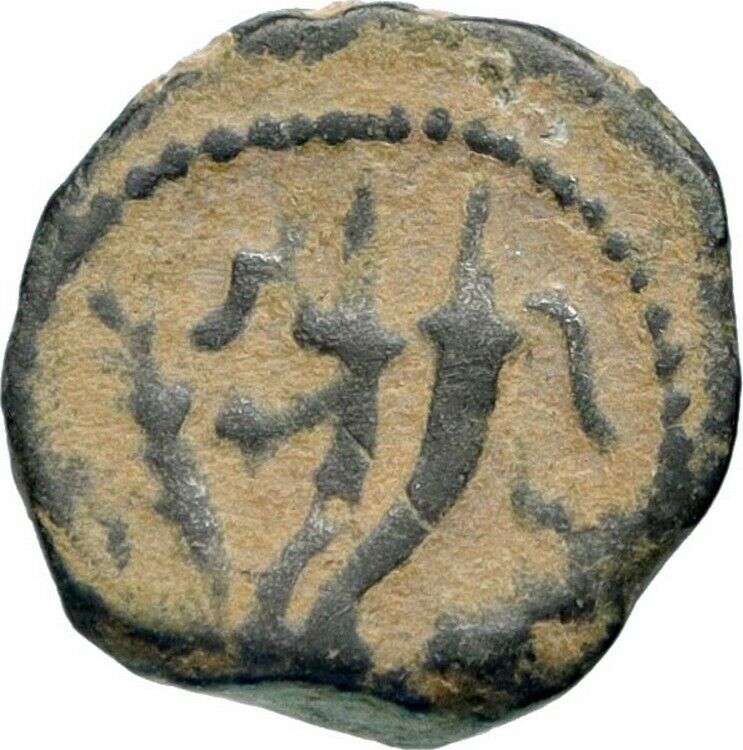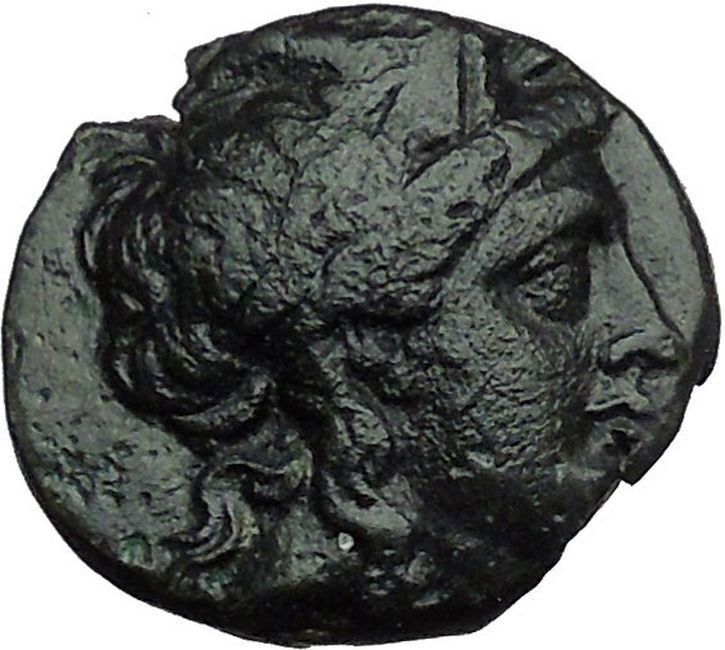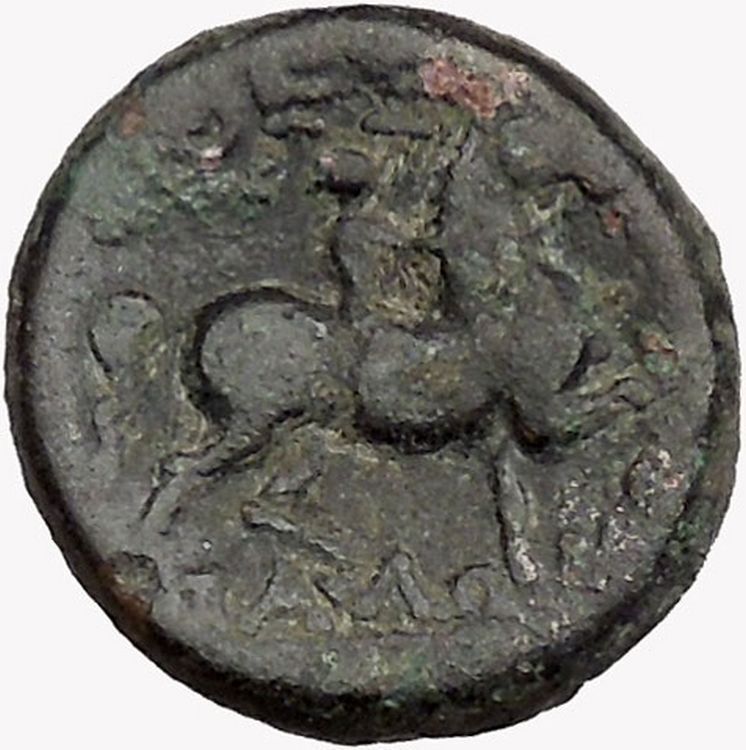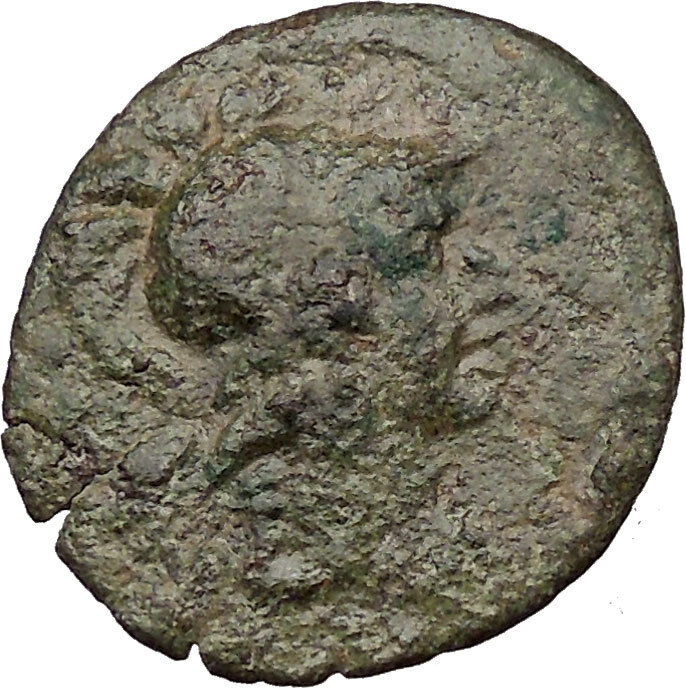|
Greek city of Tabai in Caria
Bronze 18mm (5.58 grams) Struck circa 100-25 B.C.
Reference: Sear 4946 var.
Laureate head of Zeus right.
Capos of the Dioscuri right, caduceus between; TABHNΩN
beneath.
Situated in the interior of the country, near the
Phrygian border, Tabai derived its name from the Carian or Lydian word Taba,
meaning rock.
You are bidding on the exact item pictured,
provided with a Certificate of Authenticity and Lifetime Guarantee of
Authenticity.
Pollux and
Castor or Polydeuces were twin brothers in
Greek
and
Roman mythology
and collectively known as the
Dioskouroi. They were the sons of
Leda
by
Tyndareus
and
Zeus respectively, the brothers of
Helen of Troy
and
Clytemnestra
, and the half-brothers of
Timandra
,
Phoebe
,
Heracles
, and
Philonoe
. They are known collectively in Greek
as the Dioscuri (Latin:
Dioscūrī;
Greek
: Î�ι�Œ�ƒÎºÎ¿�…��οι,
Dioskouroi, “sons of Zeus”) and in Latin as the Gemini (“twins”)
or Castores. They are sometimes also termed the Tyndaridae or
Tyndarids , later seen as a reference to their father and stepfather
Tyndareus
.
In the myth the twins shared the same mother but had different fathers which
meant that Pollux was immortal and Castor was mortal. When Castor died, Pollux
asked Zeus
to let him share his own immortality with
his twin to keep them together and they were transformed into the
Gemini constellation
. The pair were regarded as
the patrons of sailors, to whom they appeared as
St. Elmo’s fire
.

Rape of the Daughters of Leucippus by
Rubens, ca. 1618.
The caduceus from
Greek
“herald’s staff” is the staff carried by
Hermes
in
Greek mythology
. The same staff was also borne
by heralds in general, for example by
Iris
, the messenger of
Hera. It is a short staff entwined by two
serpents
, sometimes surmounted by wings. In
Roman iconography it was often depicted being carried in the left hand of
Mercury
, the messenger of the gods, guide of
the dead and protector of merchants, shepherds, gamblers, liars, and thieves.
As a symbolic object it represents Hermes (or the Roman Mercury), and by
extension trades, occupations or undertakings associated with the god. In later
Antiquity
the caduceus provided the basis for
the
astrological symbol
representing the
planet Mercury
. Thus, through its use in
astrology
and
alchemy
, it has come to denote the
elemental metal
of the same name.
By extension of its association with Mercury/Hermes, the caduceus is also a
recognized symbol of commerce and negotiation, two realms in which balanced
exchange and reciprocity are recognized as ideals.[4][5]
This association is ancient, and consistent from the Classical period to modern
times. The caduceus is also used as a symbol representing printing, again by
extension of the attributes of Mercury (in this case associated with writing and
eloquence).
The caduceus is sometimes mistakenly used
as a symbol of medicine and/or medical practice
,
especially in
North America
, because of widespread confusion
with the traditional medical symbol, the
rod of Asclepius
, which has only a single snake
and no wings.
The term kerukeion denoted any herald’s staff, not necessarily
associated with Hermes in particular.[7]
Lewis Richard Farnell
(1909) in his study of
the cult of Hermes assumed that the two snakes had simply developed out of
ornaments of the shepherd’s crook used by heralds as their staff.[8]
This view has been rejected by later authors pointing to parallel iconography in
the Ancient Near East. It has been argued that the staff or wand entwined by two
snakes was itself representing a god in the pre-anthropomorphic era. Like the
herm
or
priapus
, it would thus be a predecessor of the
anthropomorphic Hermes of the classical era.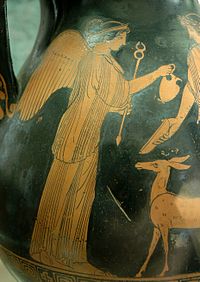
Ancient Near East
William Hayes Ward
(1910) discovered that
symbols similar to the classical caduceus sometimes appeared on
Mesopotamian cylinder seals
. He suggested the
symbol originated some time between 3000 and 4000 BCE, and that it might have
been the source of the Greek caduceus.[10]
A.L. Frothingham incorporated Dr. Ward’s research into his own work, published
in 1916, in which he suggested that the prototype of Hermes was an “Oriental
deity of Babylonian extraction” represented in his earliest form as a snake god.
From this perspective, the caduceus was originally representative of Hermes
himself, in his early form as the Underworld god
Ningishzida
, “messenger” of the “Earth Mother”.[11]
The caduceus is mentioned in passing by
Walter Burkert
[12]
as “really the image of copulating snakes taken over from Ancient Near Eastern
tradition”.
In Egyptian iconography, the
Djed pillar is depicted as containing a snake in a frieze of the
Dendera Temple complex
.
The rod of Moses
and the
brazen serpent
are frequently compared to the
caduceus, especially as Moses is acting as a messenger of God to the
Pharaoh
at the point in the narrative where he
changes his staff into a serpent.[13]
Classical antiquity
Mythology
The
Homeric hymn
to Hermes relates how Hermes
offered his lyre fashioned from a tortoise shell as compensation for the
cattle he stole
from his half brother
Apollo
. Apollo in return gave Hermes the
caduceus as a gesture of friendship.[14]
The association with the serpent thus connects Hermes to
Apollo
, as later the serpent was associated
with Asclepius
, the “son of Apollo”.[15]
The association of Apollo with the serpent is a continuation of the older
Indo-European
dragon
-slayer motif.
Wilhelm Heinrich Roscher
(1913) pointed out
that the serpent as an attribute of both Hermes and Asclepius is a variant of
the “pre-historic semi-chthonic serpent hero known at Delphi as
Python
“, who in classical mythology is slain by
Apollo.[16]
One Greek myth of origin
of the caduceus is part of the
story of Tiresias
,[17]
who found two snakes copulating and killed the female with his staff. Tiresias
was immediately turned into a woman, and so remained until he was able to repeat
the act with the male snake seven years later. This staff later came into the
possession of the god Hermes, along with its transformative powers.
Another myth suggests that Hermes (or Mercury) saw two serpents entwined in
mortal combat. Separating them with his wand he brought about peace between
them, and as a result the wand with two serpents came to be seen as a sign of
peace.[18]
In Rome, Livy
refers to the caduceator who
negotiated peace arrangements under the diplomatic protection of the caduceus he
carried.
Iconography
In some vase paintings ancient depictions of the Greek kerukeion are
somewhat different from the commonly seen modern representation. These
representations feature the two snakes atop the staff (or rod), crossed to
create a circle with the heads of the snakes resembling horns. This old graphic
form, with an additional crossbar to the staff, seems to have provided the basis
for the graphical
sign of Mercury
(☿) used in
Greek astrology
from Late Antiquity.[19]
Use in alchemy
and occultism
As the symbol of both the
planet
and the
metal
named for Mercury, the caduceus became an
important symbol in
alchemy
.
The
crucified serpent
was also revived as an
alchemical symbol for
fixatio
, and
John Donne
(Sermons 10:190) uses
“crucified Serpent” as a title of
Jesus Christ
.
Symbol of commerce
A simplified variant of the caduceus is to be found in dictionaries,
indicating a “commercial term� entirely in keeping with the association of
Hermes with commerce. In this form the staff is often depicted with two winglets
attached and the snakes are omitted (or reduced to a small ring in the middle).[20]
The Customs Service of the former
German Democratic Republic
employed the
caduceus, bringing its implied associations with thresholds, translators, and
commerce, in the service medals they issued their staff.
Misuse as symbol
of medicine
It is relatively common, especially in the United States, to find the
caduceus, with its two snakes and wings, used as a symbol of medicine instead of
the correct rod of Asclepius, with only a single snake. This usage is erroneous,
popularised largely as a result of the adoption of the caduceus as its insignia
by the
US Army medical corps
in 1902 at the insistence
of a single officer (though there are conflicting claims as to whether this was
Capt. Frederick P. Reynolds or Col. John R. van Hoff).[21][22]
The rod of Asclepius is the dominant symbol for professional healthcare
associations in the United States. One survey found that 62% of professional
healthcare associations used the rod of Asclepius as their symbol.[23]
The same survey found that 76% of commercial healthcare organizations used the
Caduceus symbol. The author of the study suggests the difference exists because
professional associations are more likely to have a real understanding of the
two symbols, whereas commercial organizations are more likely to be concerned
with the visual impact a symbol will have in selling their products.
The initial errors leading to its adoption and the continuing confusion it
generates are well known to medical historians. The long-standing and abundantly
attested historical associations of the caduceus with commerce, theft,
deception, and death are considered by many to be inappropriate in a symbol used
by those engaged in the healing arts.[22]
This has occasioned significant criticism of the use of the caduceus in a
medical context.
In the
ancient Greek
religion
,
Zeus
zews
zooss
;
Ancient Greek
: ;
Modern Greek
: , Dias) was the “Father of Gods and men” who ruled the Olympians of
Mount Olympus
as a father ruled the family. He was the
god of sky
and
thunder
in
Greek mythology
.
His
Roman
counterpart is
Jupiter
and
Etruscan
counterpart is Tinia
.![The Jupiter de Smyrne, discovered in Smyrna in 1680[1]](https://upload.wikimedia.org/wikipedia/commons/thumb/c/c8/Jupiter_Smyrna_Louvre_Ma13.jpg/200px-Jupiter_Smyrna_Louvre_Ma13.jpg)
Zeus was the child of
Cronus
and
Rhea
,
and the youngest of his siblings. In most traditions he was married to
Hera, although, at the
oracle of Dodona
,
his consort was
Dione
:
according to the Iliad
,
he is the father of
Aphrodite
by Dione. He is known for his erotic escapades. These resulted in many godly and
heroic offspring, including
Athena
,
Apollo
and Artemis
,
Hermes
,
Persephone
(by Demeter
),
Dionysus
,
Perseus
,
Heracles
,
Helen of Troy
,
Minos
,
and the Muses
(by Mnemosyne
);
by Hera, he is usually said to have fathered
Ares,
Hebe
and Hephaestus
.
As
Walter Burkert
points out in his book, Greek Religion, “Even the gods who are not his
natural children address him as Father, and all the gods rise in his presence.”
For the Greeks, he was the
King of the Gods
,
who oversaw the universe. As
Pausanias
observed, “That Zeus is king in heaven is a saying common to all men”. In
Hesiod’s Theogony
Zeus assigns the various gods their roles. In the
Homeric Hymns
he is referred to as the chieftain of the gods.
His symbols are the
thunderbolt
,
eagle
,
bull
,
and oak
.
In addition to his Indo-European inheritance, the classical “cloud-gatherer”
also derives certain iconographic traits from the cultures of the
Ancient Near East
,
such as the
scepter
.
Zeus is frequently depicted by Greek artists in one of two poses: standing,
striding forward, with a thunderbolt leveled in his raised right hand, or seated
in majesty.
Zeus, poetically referred to by the
vocative
Zeu pater (“O, father Zeus”),
is a continuation of *Di̯ēus,
the
Proto-Indo-European
god of the daytime sky,
also called *Dyeus
ph2tÄ“r (“Sky Father”).[9]
The god is known under this name in
Sanskrit
(compare
Dyaus/Dyaus Pita
),
Latin
(compare
Jupiter
, from Iuppiter, deriving
from the
Proto-Indo-European
vocative *dyeu-ph2tēr[10]),
deriving from the basic form *dyeu– (“to shine”, and in its many
derivatives, “sky, heaven, god”).[9]
And in
Germanic mythology
(compare *TÄ«waz
>
Old High German language
Ziu,
Old Norse
Týr
), together with Latin deus,
dīvus and Dis (a variation of dīves[11]),
from the related noun *deiwos.[11]
To the Greeks and Romans, the god of the sky was also the supreme god. Zeus is
the only deity in the Olympic
pantheon
whose name has such a transparent
Indo-European etymology.
Tabae is a Catholic
titular see
. The original diocese was in
Caria
, a
suffragan
of
Stauropolis
; according to
Strabo
[1]
it was located in a plain in
Phrygia
on the boundaries of Caria. The place
is now Tavas
, near
Kale, Denizli
in
Turkey
; some inscriptions and numerous ancient
remains have been found.
Stephanus Byzantius
mentions two cities of this
name, one in Lydia
, the other in Caria.
Livy[2]
says that it was on the frontier of
Pisidia
towards the coast of the
Gulf of Pamphylia
. The town in question,
however, some coins of which are extant, was one which claimed to have been
founded by one Tabus. Others derive its name from tabi, which in Semitic
languages means “good”, and others from a native word taba, meaning
“rock”, which seems a probable derivation.
History
In 189 BC, the consul
Gnaeus Manlius Vulso
, having defeated the
inhabitants who blocked his passage, exacted from Tabae a fine of 25
talents
and 10,000
medimni
of wheat.
Bishops
Three bishops of Tabae are known:
- Rufinus, present at the
Council of Ephesus
(431);
- Severus, at Constantinople (553);
- Basilius, at Nicæa (787).
The
Notitiæ Episcopatuum
continue to mention
the see among the suffragans of
Stauropolis until the 13th century.
As of 2008, the titular is Gerard Paul Bergie.
|








![The Jupiter de Smyrne, discovered in Smyrna in 1680[1]](https://upload.wikimedia.org/wikipedia/commons/thumb/c/c8/Jupiter_Smyrna_Louvre_Ma13.jpg/200px-Jupiter_Smyrna_Louvre_Ma13.jpg)
